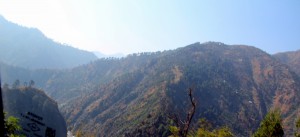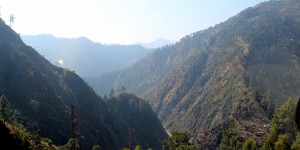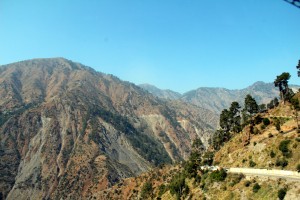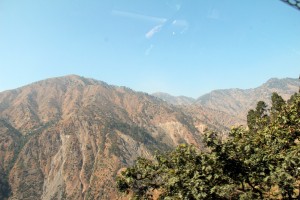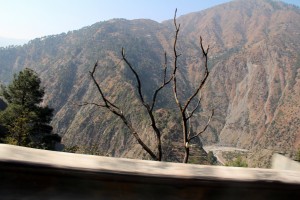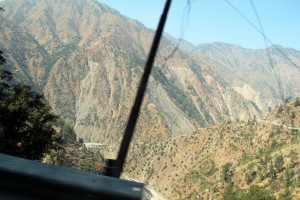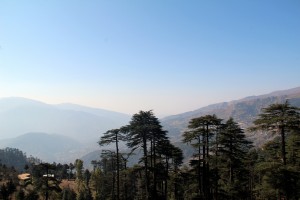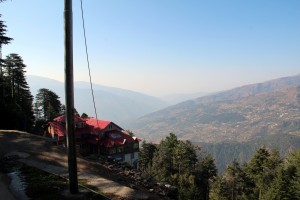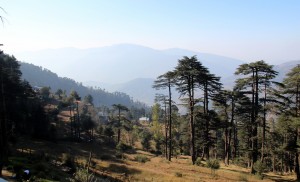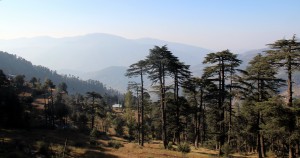Trip To Kashmir 2021
My six-week trip to India was a boutique of reciprocated sentiments for my motherland, especially the part spent in Kashmir. As the nature of human life is, it was not perfect. Along with the flowers there were some thorns.
I spent seventeen glorious days in the lap of my mother, Kashmir, in spite of it being in the throes of winter. I visited the sites that are usual for me when I visit it. Place of my birth in Malik Angan, place where I lived Malikyar, my college Amar Singh College, my later matamal sites at Mandir Bagh and Jawahar Nagar. Also, visited our close relative Shangaloo’s house at Kralkhud, near Habba Kadal. Visited also Tullamulla, Hariparbat, Zyeshta Devi temple, and Shankaracharya. Went also to Shalimar, Nishat, and Chashmashahi, visiting the first two more than once. Throughout my stay Srinagar was under the blanket of fog, which diminished the beauty of Dal Lake. But in spite of it I had three shikara rides on it, and its beauty was still enthralling, though reduced. I made umpteen visits to Ahdoo’s for their authentic Kashmiri cuisine.
Outside Srinagar I visited Sonamarg, Baltal, Pahalgam, and Gulmarg. Baltal was stunning, its grandeur especially under snow is awesome. Pahalgam was the same paradise as it has been before. A pearl of beautiful small valleys studded with awesome mountains and ethereal pine trees. I first time went to Betab Valley, Chandanwari, and Ashmukam. Also visited the temple at Mamleshwar, and Chris Zasndee’s Himalayan Cheese Factory. Pine and Peaks hotel where I stayed, which was recommended by my travel agent, was excellent. Its view of Pahalgam from its rear side is great. Their food was excellent.
Gulmarg was beautiful too, but I am repelled by its 3.5 square mile central valley, which has been neglected, I believe, throughout its history. I have written about how it can be converted to a beautiful valley studded with gardens, trees, picnic spots, walkways, etc. My friends have urged me to send it to the government for their action. But knowing its caliber I have been reluctant to do that. Rest of Gulmarg is awesome, especially when you go up on the Gondala to Kongdoori. I also went to a waterfall in Tangmarg.
I spent seventeen very beautiful days in Kashmir. My micro-planning of the trip paid off. The selected hotels were very good, but Shaw’s Inn at Gulmarg was off the mark. Four days at the fabled Taj Vivanta at Srinagar, at about 30,000 INR per day, were great. It has a great location atop a hill overlooking Dal. But due to the persistent fog that was not visible, the sole reason of my selecting it. But otherwise the hotel is very good.
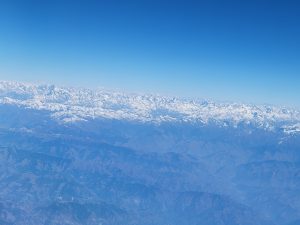
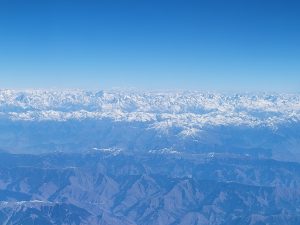
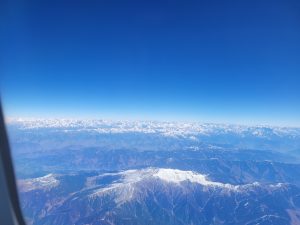
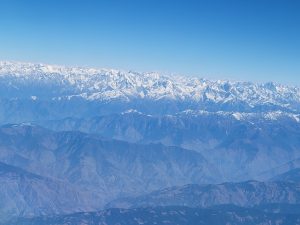
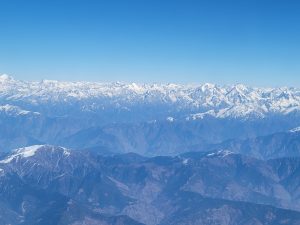
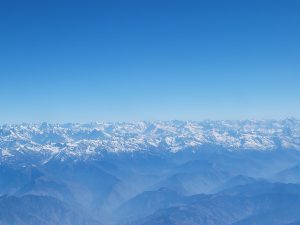
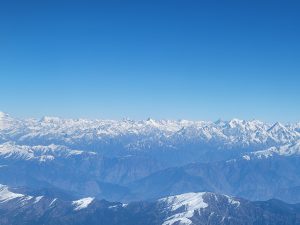
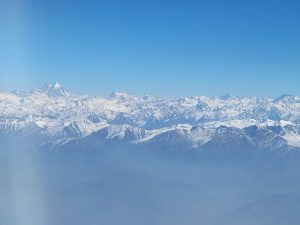
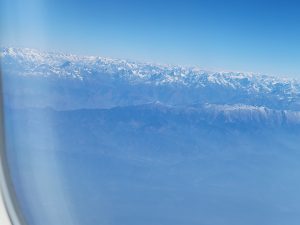
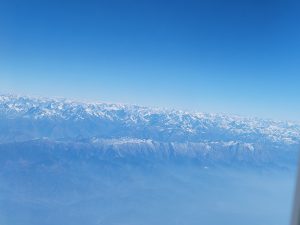
Suffern, New York, January 1, 2022
maharaj.kaul@yahoo.com
Just Being There: Diary Notes of my Trip to Kashmir in 2011
I did not keep a diary during my ambitious trip to Kashmir in 2011, as I generally never have kept diaries, but only diary notes. The trip was ambitious as I wanted to reconnect with my roots after a gap of nine years. Thoughts occurred to me with what goals should I visit it, but then I abandoned the notion of goals and instead conceptualized the objective of my trip to be just being there.
These Diary Notes have been written in a stream of consciousness style, capturing my nascent observations. But I have captured the trip in six full-fledged articles, which were published in 2011, and are attached here. The diary notes are a supplement to the articles. The articles are also available on my website, www.kaulscorner.com. The articles are:
- Fleeting Moments at Pahalgam (83)
- Siesta at Manasbal Lake (84)
- In Search of the Soul of Gulmarg (85)
- Touching the Remnants of Time in Old Srinagar (86)
- At the Feet of Shiva at Amarnath (87)
- Meeting Raj Begum (88)
The numbers in parentheses are the article numbers in the Essays section of the site.
But I still had a list of things to do, which comprised of meeting Raj Begum; going down Jhelum in a shikara from Zero Bridge to Safakadal Bridge and back; visiting Pahalgam, Gulmarg, and Sonamarg, the last one I had never been to. Also, visiting the houses of my birth and childhood at Malikangan and Malikyar. Furthermore, visiting Zeethyar, which I had also never been to. Living in a houseboat, which I had never done, as natives would not live in a houseboat, that was for the visitors to do. The last but not the least was eating Nadirmunjas, my most favorite snack, which I had not done in a while. In the end I ended up doing a lot more. I got a lot of ideas on Kashmir and other subjects to write on, and I took several hundred pictures and some videos, whose quality has endeared them to a huge number of people all these years. Based on the last genre I made a 35-minute-long composition of stills and videos which I called “Kashmir: A Trip to the Hallowed Land, which has earned a lot of popularity. It is available on You Tube, as it is too long to be attached to an email.
Diary Notes
Indian Scene in General:
- I witnessed more exuberance and energy than before, let us say ten years earlier.
- Change in dress. White colored clothing and chapals were no longer the most favored, as they were for generations, but were supplanted by colored clothing and shoes and sneakers for footwear. Jeans were ubiquitous, even many women wore them, though not ultra-tight variety used in the West.
- Mall mania had captured Indians.
- People were copying Westerners in many things – unquestioningly.
- Young men and women at airports and hotels were very polite, alert, and efficient.
- TV – Westernized entertainment, seemingly scant attention paid to details and depth.
- Indian courtesy is deep and persuasive. It comes from Indian ethos – at times bordering on servility.
- Indians paying scant attention to environment. Appearance and harmony with the scene do not matter.
- Indira Gandhi Airport based on Western concepts of architecture, functionality, and style.
Srinagar
- Trip from airport to the hotel: cabbie was supposed to pay me a balance of 50 rupees, but he would not, even when reminded about it. He would not move my bags to the hotel after dropping me at its gate.
- Sun Shine Hotel where I stayed was wrongly spelled on its huge sign, it should have been Sunshine. Such glaring English spelling errors were rife in Kashmir, especially hurting were the ones on some shikaras, as are in the rest of India.
Hotel was disappointing. No internet, A/C, and shower. Looked shabby. Being at Dalgate it commands a view of the row of houseboats, Hariparbat, and a sliver of Zabarwan mountain.
- Changing my cell phone to the one operable in Kashmir was a big hassle. A man at J&K Reception Center was very excited to know that I was born in Kashmir. He was enthusiastically helpful in registering me for Amarnath trip, which was necessary for me to qualify for the phone change. Even though I was not yet decided upon undertaking that trip.
- Visiting Kashmir is reliving some of my childhood, when my consciousness was developed and the course of my life was established.
- Shalimar garden is in a better shape than before (2002).
- Made a decision to go to Amarnath, in spite of my age. It was not on my list. Made it not on the basis of religious feeling, but on the basis that it was there, an inspiration used by the British mountaineer, George Mallory (1886-1924), in his three failed attempts to reach Mt. Everest. Planned to go to Baltal on road, then by a helicopter to Panchtarni, then on horseback to the cave.
- There is still so much muck on the roads: garbage, human and animal excreta. Repellant odors float in the air, excruciatingly messy sites abound, depressing the fine spirits of the visitors. But natives have learned to ignore them.
- Expansion of markets, housing, etc. being made without an overall plan.
Comments on Kashmiris
- Even though Kashmir has become more technologized, economically securer, but the old ways of its people’s (KM’s) thinking persists.
- Kashmiris seem to be alive but without a vision. They think as long as they do something it is progress.
- Kashmiris are dreamers, the people who stick to their dreams, irrespective of anything that happens, and even if the dream is unrealizable. Such a personality can lead to insanity.
- The people seem to recognize the futility of the two decades of civil war, but they do not know how to get out of it. Having achieved almost nothing in the direction of independence, they are frustrated and have become cynical.
At the Feet of Shiva At Amarnath
Touching the Remnants of Time in Old Srinagar
In Search of The Soul of Gulmarg
Suffern, New York, April 10, 2018
maharaj.kaul@yahoo.com
Patnitop : A Reluctant Journey
On several recent visits to Kashmir Valley my friends urged me to visit Patnitop, located in the adjoining province of Jammu, but I would reject the suggestion on the ground that how more beautiful could it be than Kashmir. But in 2013 I gave up resisting my friends and decided to take a chance.
After five hours of car drive from Srinagar I landed in Patnitop, a place I had heard praised lavishly for the last four decades. But because I have trained myself strongly to disregard common people’s evaluations on beauty and truth, I entered Patnitop without preformed views on it.
Going gingerly at a snail’s pace on the serpentine road leading to Patnitop the scene gradually changed to sublimity. Here was a place at once dreamy and serene, reverberating the images of eternity one had conjured up. The backdrop of the folded mountains, the enigmatic majesty of the blue pine trees, the mystery of the valley below, and the dance of the mountain contours, all wove an experience of beauty, awe, and humility. Truly, the most sublime thing in human life is aura and mystery of nature.
I realized Kashmir Valley does not have a type of beauty that Patnitop has.
Suffern, New York, April 10, 2016
maharaj.kaul@yahoo.com
At The Feet Of Shiva At Amarnath
After having left Kashmir in 60s to study engineering at Banaras, and not knowing if I was returning back there to work, I was haunted by the lost opportunity to visit Amaranth. Most of the male members of my family and most of my friends had made the trip.
How circumstances had made me be deprived of the visit, I do not remember in detail, but I know my miss was circumstantial. But what is surprising is that I could have kept on harboring my desire to visit Amaranth even over so many decades. What was in it that kept me pulling toward it? Religious ardor? Hiking pleasure? Pull of the stunning natural scenery? I do not know what it was. Like the British mountaineer George Mallory’s (1886-1924), (who had made three unsuccessful attempts to climb Mt. Everest), answer, “Because it is there,” to the question, “Why do you want to climb Mt. Everest?,” I did not have a good explanation for harboring my desire to visit Amarnath for so long, but only my strong feeling to do so.
When I decided to visit Kashmir this August, naturally the thought of visiting Amaranth occurred to me. But I reserved my decision to go there at a later point during the trip, so that I was absolutely certain that I could do so. The reason for doing that was because I had to consider my physical strength at my age to go on high mountains. When I reached Kashmir, within a day I decided that I will go to Amaranth.
On Aug. 10, I got up at 4:00 AM to prepare for the trip to Amarnath. By 5:00 AM I was on the road to Baltal, about 56 miles from Srinagar. It was an eerie feeling to drive at that hour, as the towns and villages were shutdown. In the absence of people places look different; their real personalities come out. How innocent do they look, ready to wear whatever garb humans put them in. Beyond the long strip of the town of Ganderbal, we started encountering the more mountainous terrain. Kangan is a lovely blend of hills, trees, and water, just 25 miles from Srinagar. As we go further beyond this point we start feeling the almost continuous presence of the river Sind: scintillating, spirited, sonorous. What a grace and character it has. River Liddar, flowing in Pahalgam valley, is small and low-key in comparison. On the way we saw some people out of their homes in pre-dawn walks. The silence of the hour puts the walker in a meditative mode. What a good way to start a day in one’s life. I could not but see how much simpler is life in villages and towns away from metropolises. Towns of Thajewas and Sonamarg followed.
Driving from Sonamarg, just about 3 to 4 miles from Baltal, the road suddenly turned very rough; it was as yet unpaved road. It was very annoying, as one was close to the significant destination of Baltal, during the yatra period, from where the helicopters ferry to Panchtarni, the base-camp of Amarnath. Why cannot the government choose its priorities right?
Baltal is a meadow-like place, with lovely mountainscape. On this sunny morning it looked a forlorn, dreamy place. Within the fenced area of the heliport two companies operate. We were several dozen passengers waiting for our turns to be ferried to Panchtarni. After an hour’s wait beyond the schedule, we were carefully seated in the plane. I was accompanied by three ladies and a man in the rear compartment. As the helicopter lifted off, after a usual hiccup, the three ladies got visibly scared and some of them started praying. Within a minute we were smoothly flying. We flew through a mountain pass that seemed very adventurous, especially because the geography was new to me. After five minutes we landed at Panchtarni, the base-camp of the Amaranth cave, which is at an elevation of 12,729 ft.
Panchtarni is valley-like, contoured by dramatically rugged mountains. Like most high mountainscapes, it has the aura of otherworldliness, the mood of renunciation. I felt I could live here for a while: to meditate on a spirit higher than that is manifest to us through senses.
I decided to go on a horseback to the cave rather than walk, considering my aging frame.
Amnarnath cave is only about four miles from Panchtarni but the road is fraught with high steep. If that were not enough hardship, the road is just a few feet wide, wildly meandering at places, unpaved, and strewn quite often with huge rocks. And there are ravines thousands of feet below to scare you. In U.S. such a route would be impermissible for mass travel for safety reasons. Why would the government not make this heavily trafficked road safe? It would not need any foreign technology to do that, just rupees, planning, and effort.
My trek started smoothly, fuelled as it was with high motivation. But as I climbed higher into the folds of the mountains, my leg bones started to pain. But I am not an easy quitter. I have many times ruined my projects by not quitting early enough; I am a prisoner of my will. As I moved on with the caravan of yatris, I started thinking of how people undertake this arduous and expensive journey. Many of the yatris I saw were old, much older than I am, and also seemed to be of modest financial means. What gave them the strength to first embark on this journey ? It was not much difficult for me to understand that it was their faith in God that propelled them.
As we climbed higher into the mountain my legs became sore and I started thinking of what to do. I could walk, perhaps relieving pressure on my legs, or I could tell my horseman to look into the saddle straps and stirrups, as their faulty set up might be the culprit. But I did not convert these ideas into actions, for reasons unknown to me. Insane that it was, I just kept on going like the soldiers in the poem The Charge Of The Light Brigade, whose mission was dictated by the order: Theirs is not to reason why/Theirs is but to do and die. Sometimes I looked at the very old woman in our group, whose back was doubled up; I wondered how she was coping with the journey. But because she was ahead of me and so I was unable to see her face, I could not tell. There were other yatris, who were older than I am, but none appeared to be in pain. I knew, with the utmost confidence of my being, that the cancellation of the trip was not an option I had. Remembering that in other similar situations, when I was under intense pressure to continue on a path because I was in utter discomfort, I had kept on. This faith in myself propelled me ahead in my present calamity.
The scenery on the way is mystic and tranquilizing; you feel you are far away from the world. You are solely focused on the journey and its destination. Those who are religious must be thinking of God, those who believe in the mystery and power of nature think of it. They are two different ways for humans to live in harmony with themselves and the outside world. Such journeys as we were undertaking unconsciously detach you from yourself and make you think of some reality higher than that. Living in the survival struggle, unfairness, and coldness of the world, compels most of the people to find the security in one’s self. That leads to the creation of ego, which then becomes a vicious black-hole, from where the escape becomes an extraordinarily difficult task. If the world were different, as it has been at times in the history of mankind, human beings would live more peacefully than they do now. Today’s maya jaal is a tough prison, braced as it is with heavy materialism and its inhuman sister, technology.
The thinker in me could not avoid, although I tried my utmost not to think on the subject, thinking about why people undertake an arduous and an expensive journey to Amaranth. There were many very old men and women, physically decrepit, for whom the journey was hazardous. What is this force, this compulsion, which pulled them to Amarnath? Since the birth of man in cosmos he has been seeking the ultimate reality; as if his very birth involved the separation from it, so that he was compelled to reunite with it. This eternal longing of man to be with God is the very fabric of life, the essence of human existence, the driving force of the propagation of human soul. Man wants to be reunited with the flame that in the first place propelled him into the journey through the world. Why did gods create this puzzling game? We do not know, but in the absence of our understanding of it, we have to assume that they had a good reason for it.
The horses we were riding on were of small build but were tough. They knew their job very well. In many situations, when there was more than one path available to negotiate, from a human intelligence point of view, all horse would follow the same path. They were very dexterous in negotiating complex maneuvers; for example, when climbing up and down a rock. When a horse appeared to be slackening in his efforts, the horseman would admonish it with a particular noise, frrah, and the horse would react with the expected improvement in its performance.
The cave is on the other side of the mountain from which one starts at Panchtarni. So, when you turn the side of the mountain, the emotion to have Shiva’s darshan rises. Also, the trek on the other side is milder. The closer you get to the cave, the lower does the altitude of the road gets. For those who are on a maiden journey, the emotions for darshan are accompanied with curiosity and the possibilities of surprises. Reaching the last mile to the destination the crescendo of emotions rises perceptibly. Finally, you reach Amarnath, but are crestfallen to learn that you have still some more journeying to do to reach the cave. There are about 70 steps on a steep incline to climb to get into the Amarnath cave. My leg pain seemed to vanish, except that its shadow reverberated in the memory. I thought I needed a moment of respite before the final push to darshan. I went into a tented daaba and slaked my thirst and hunger by devouring some snacks. While still eating I learnt that the place was a charity operation. I could not but feel admiration for those contributing money and efforts for it; the world was not, after all, completely insensitive.
After nourishing and resting the beaten body a little, I strode on toward the steps. Right before going over the first of them I took a look at the cave. It seemed larger than it had appeared in the pictures; maybe, because of the three-dimensionality of the view. The largeness of the mouth of the cave portended that it might be very deep as well, an abbreviated cosmos of spirituality. At this point in my journey the mystery of Amaranth burned scintillatingly in my mind, the prospect of being in the cave shortly quickened my breath. I was very surprised to see that I too wanted to have a darshan. I realized that aren’t we all human beings searchers of something larger than our existences, something more beautiful than our environments.
The fierce ruggedness of Mt. Amarnath and its companion mountains seemed to be in sharp contrast with the spiritual light enshrined there. Were the mountains protecting something sensitive and inestimable? The legend that Lord Shiva revealed to his consort Parvati the secrets of life and eternity in the cave flashed across my mind. I felt that was an awesome place he had chosen for such an awesome revelation.
But the climbing of the steps became painful, because of their steepness and because of the accumulated tiredness of the journey already made. Even young people, some of whom looked less than half my age, were taking breathers every ten steps climbed. This observation made me feel less critical of my self-control.
Finally, I entered the cave, in a line of yatris. The first impression was that its depth was shallow, about 20 ft., compared to its outside width and height of about 45 and 150 ft. There was plenty of time to be inside the cave as at this time of close to the end of the yatra there were only a few hundred yatris. There was no darshan, which was not unexpected for this time of the year. I was told that in June there was a full 16 ft. darshan. There is a popular theory floating around that the military helicopter traffic near the cave had raised the temperatures in the cave, resulting in the early disappearance of the darshan. But I was not disappointed by the lack of darshan, as it was not its physical presence that was necessary for my mind to appreciate its significance. For me it is the legend of Amarnath that is so captivating, not its scientific authenticity, because it signifies to me the eternal human thirst for truth, beauty, and knowledge. I spent fifteen minutes looking at the wall in the cave where Shiva’s, Parvati’s, and their son Ganesha’s lingums usually stand. I imagined the millions of people, who over centuries have visited the cave to find their salvation. I was moved by this human yearning to find the release from the bondages of the flesh and the shackles of the world. I could not help thinking the great irony of man’s life: though one of the supreme creations in the universe, he is in pain throughout his stay in the world, the release from which he so ardently seeks.
After having darshan the mood of satisfaction invisibly penetrated me. I was no longer thinking but felt to be in a benign daze; as if submerged in a deep lake, from which I did not want to be disturbed for awhile.
After taking prasad and resting a little the return trip to Panchtarni started. A mood of bathos slowly descended. The return journey was easier but yet strenuous, as the same elements of the narrowness of the road, punctuated with huge rocks, and extreme steepness existed as in the other direction. Slowly and surely we trekked to Panchtarni, a dreamy valley, laced with beautifully rugged mountains, reminding one of eternity.
From Panchtarni we travelled back to Baltal by a helicopter. From there on I boarded my waiting taxi. We stopped at the town of Sonamarg: a place of almost absolute tranquility, pregnant with a mystic mood, transporting one to a different cosmos.
After following the dancing rhythms of the whitewater river Sind for quite a while, we reentered the civilization. Passing through the hamlets, villages, and little towns once again impressed on me the superiority of living close to nature.
Reaching my hotel in Srinagar, I felt that I had still not been able to lift the corner of the veil of mystery over my lifelong urge to visit Amaranth.
Suffern, New York November 7, 2011 www.kaulscorner.com maharaj.kaul@yahoo.com
Touching The Remnants Of Time In Old Srinagar
On August 19, at about noon, I was in front of the house I was born at several decades ago. While experiencing the moment I could feel the flow of time. This was the place where the clock of my life started ticking. I was born at my maternal grandfather’s house, which was inhabited by six Karihalloo brothers and their families. The joint household was so large that in the evening an attendance would be taken of the youngsters to make sure none them were missing after an afternoon of games and fun. I became the beloved grandchild of my grandfather, Dama Kaul Karihalloo, by virtue of the transference of his love for his favorite daughter, Arni, who was renowned for her fine demeanor, charming shyness, and beauty.
The Karihalloo house was located at Fateh Kadal, near Malik Angan. Relying on my photographic memory of places, I looked for the right lane to turn into, but was prevented to find it, by the changes that several decades since my last visit to my birthplace had wrought to its neighborhood. Finally, I resorted to asking people on the street for the direction to the Karihalloo house. When it seemed that no one could help me, an old man, perhaps in his 80’s, confidently told me that he could help me. I requested him if he could walk me up to the house, instead of giving me its directions. He enthusiastically escorted me to my destination; without him I would have had difficulties in finding it. All the markers I had remembered for the house had been swallowed by the vortex of time. One of the salient markers of the house, the Madan house, which was in close proximity, I was unable to locate. The people living in the house after Karihalloo’s had taken a good care of it, as it looked intact, as well as spruced up. I conjured up the images of the halcyon days of Karihalloos, living in familial bliss and with a strong identity, unlike most of the families in the Age Of Technology we live in. I mused on why and when I was orphaned from the clan, detached from the hub.
I went to see the house in Malikyar where I spent most of my childhood and young adulthood, just up to the point of leaving college for a professional college outside Kashmir. I thought I knew the road from Karan Nagar to my house, having traversed it several thousand times. While the starting point was identifiable but as my taxi went along the road it changed drastically. We continued on it, not knowing any better, till we hit the new Fateh Kadal, called Biscoe Bridge; having a good idea of the location of the bridge from my previous visit, I thought I would know how to reach my house. So, the taxi driver followed my directions, until we discovered we were lost. This was a shock to my confidence. While making inquiries from the people on the street, an old man gave me the directions, but he wondered who I was. Upon giving him my identity, he got very excited, and later emotional, as he revealed his. He was our neighbor Omar Bhat, he and his family had lived across our street for decades. We hugged each other and later we met again outside our former house.
Seeing my former house I was excited but also a little disappointed, as its appearance had changed. It had a new color on the outside, as well as a new roof, the windows also appeared to have changed. I started taking pictures of the house and its environs. Khet Beni’s green grocery shop was no longer there, as were not the butcher, kandar wan, Khala bisot’s, and Shudhar’s dry grocery shops. To say that the neighborhood had changed was an understatement; it had drastically changed. But the roads were better built, including the old feces-laden lanes. I was happy to see the lane near my house, which I used to take to go to college and other places, made pukka. In the old days, walking over it, especially in dark, was a risk I had no choice but to take. Our immediate neighbor, Khatbeni’s (different from the green grocer) family, had moved to suburbs (Khatbeni herself had died in 70’s). But for the mosque and woodwork shop, every other shop had changed, although the street and lane layout had remained the same. There was an open area we called bagh where we used to play, the only decent playground we had, it was now occupied by a new house. This seemed to be an encroachment from the point of view of my sentiments for the bagh.I was feeling how could they? Within a few minutes after my arrival on the scene several people gathered around me, who later I came to know were my old neighbors. Now old like me, they had changed, as I must have appeared to them. I did not recognize anyone of them, as they must not have recognized me. After introductions we were excited and the emotions gushed. Some of them wanted me to have tea with them right away. I had to tell them that I would come another day and would be happy to spend time with them, but time is a merciless maiden who must keep you on a leash to suit her agenda.
Ghulam Mohamad Durzi, the person to whom my uncle sold our former house, was in the small group of people who surrounded me once the word went out in the mohalla that I was there. He seemed to be a fine gentleman: courteous and low-key. I asked him if I could visit my former house; he graciously invited me to visit it. We entered the house where I had spent 14 years of my early life. The years in which I came to know something of human desire, relationships, and loneliness. The years that laid the foundation of my consciousness and launched the odyssey of my search for the absolute. Here was the house where I had secretly cried, was smitten with loneliness, as I was left by my parents at my uncle’s house, under the idea that remaining in Srinagar, rather than in New Delhi, where they were stationed at that time, would help my education. The seeds of my loneliness were sown earlier than they should have been. All these early experiences have contributed to what I have grown up to be now, warts-and-all.
Escorted courteously by Darzi Sahib, we went room by room in my former home. Our wut was shortened by including some of its space with the newly designed kitchen. Gone was the old earthen dhaan, replaced by a table-top type of range. The betakh had remained unchanged and the muttey koothar, the grain storage room, was where it used to be. On the second floor I passed by the koothar where I used to study. I went in the bud kuth, where my parents Babuji and Bhabi used to sleep. I looked out from one of its windows at the bazaar outside. The wooden jali below the window, where once my right hand got stuck in one of its spaces, needing an emergency intervention of someone to free it, was no longer there. Similarly, on the third floor I looked out from my uncle Papaji’s bedroom. The house looked now so much smaller than it seemed to be when I lived there. Time, for a moment, seemed to have frozen, and I traversed forward and backward on its wings.
From the kaani I looked over to my uncles’ houses and was shocked to see them splintered badly, as if a hurricane had smothered them. I asked my host what had happened. He explained that the destruction was the work of militants sometime back. I did not feel comfortable asking him the details, as they would have necessarily upset him. But what was surprising to me was that by 2002 these houses were purchased by Muslim families, but were yet destroyed by militants. Furthermore, the compound between our house and the uncles’ houses was rife with weeds, as the lack of its use over extended time would have encouraged. The site of these houses was painful, flashing in my mind momentarily the turbulent history of the last two decades.
While going through my house a memory of an event spontaneously crossed my mind. During one afternoon in 50’s I had just heard the announcement of my expected passing of the matriculation examination. Jubilantly I marched to Amira Kadal to indulge in some celebration with my friends. On the way I fell from a bicycle and broke my left arm. Seething with pain, I cancelled the celebration and walked to my matamal at Mandir Bagh to sleep off my pain. But its accentuation compelled me to visit a neighborhood hospital, Rattan Rani Hospital. Screening revealed a fracture of the elbow. Burdened with the grim news I marched to my home. Upon hearing my travail, some people present at my home that time talked about setting the elbow bones by the traditional bone setting procedure, which involved first breaking the joint in question in a rice pounding stone vat and then setting it right, of course without the use of anesthesia. I was smitten with fear at the scenario but luckily when my uncle Papaji came home he dismissed this barbaric procedure and told me he was going to take me to a hospital the following day for the scientifically established state of the art remedy.
We drove over Biscoe Bridge. Then I walked on the old Fateh Kadal, whose width has been reduced to just about 15 ft., for pedestrian use only. From there we drove toward Habba Kadal, formerly the “Times Square” of Srinagar. Passing through Chinkral Mohalla, I keenly looked for the Tarakh Halwoy shop, which sadly did not exist anymore. Again, we have the “pedestrian only” old Habba Kadal, though of full former width. There is a barrier put on the side opposite the Kanya Kadal side, for security reasons. Gone are Kapoor Booksellers and Dr. Chagtoo’s office. I walked on the old Habba Kadal and recaptured the times when I along with many boys would watch the girls returning to their homes after a day at school. For me the special moment would come when Bimla and I would stare at each other to carry on our eyes-only romance. The magic of the life on the old Habba Kadal has vanished into the layers of time.
The road between Fateh Kadal and Kralkhud , which used to be too narrow for its usage, has been widened and is of superior quality than before. At Kralkhud I looked up my relatives Shangloo’s former home. I saw a woman sitting at the second floor window, which somehow disturbed my concentration to take pictures. Kashmiris have a serious problem of staring at the outsiders. They are unaware that this action is rude behavior. 99% of the times I am able to ignore it and remain focused on taking pictures. This time I momentarily lost my will, with the result I did not take all the pictures I wanted to take. Furthermore, I did not go inside the Shangloo compound, which I had keenly planned to do.
Moving on further I went to Ganpatyar, where my poofi Bengashi used to live. My former markers for the house were nowhere in sight, as the area had changed in the decades I was away. Then I got an idea that I could get the whereabouts of the Muthu household from the people inside the Ganpatyar temple. I was surprised to see the temple had a military camouflage over it and a security check post, obviously to keep the militants away, as it is one of their prime targets for bombardment. Inside the temple, I found a marble floor tile close to the steps leading to the temple idol chamber, inscribed with my poofa Dr. Dwarika Nath Muthu’s name. This triggered a flashback of my noble uncle, who lived with high integrity and compassion for the destitute.
Beyond Ganpatyar we drove to Mandir Bagh, a place near Rattan Rani Hospital, where Karihalloos lived after they moved from Fateh Kadal. The place had changed drastically. The Karihalloo house had been replaced, a lane built through its garden, and the neighboring Saraf house replaced by a hotel. I remembered the happy childhood days spent at my matamaal. My foremost memory is that of my grandfather Baijee, whose acute love for me remains a treasure of my life. Then there was the thrill of spending time with an extended family and playing in the bamzoonth bagh.
Following day I went to Amar Singh College, where I had spent three years. Its entrance gate had been moved to the far front side of its main building. Certainly an improvement. At the time of my visit there, about 9 A.M., there were not many students in it, perhaps because it was yet too early for the classes to begin. Again a change from my days.
The building looked as stately and intact as ever to my surprise, as I had expected the inexorable saw of time to have withered it. What could have avoided that in this case of a circa 1930’s building? Excellent original design and maintenance. It buoyed my spirits to find that some things used to be done right in the past and then maintained right. The new entrance path bordered with slim and tall poplar trees looked graceful. Overall, the “campus” looked neat. Looking at the field where I had spent countless hours playing cricket, I saw a few cows lazily chewing grass; a not so unusual a sight in India. Some construction was going in the field. Turning to the inside of the building, the “U” contoured back side, where we spent hours waiting for the classes to start, watching girls, or just gossiping, had remained unchanged. I entered one of the unoccupied classrooms and was amazed to see that it had remained in form and shape the same as it was in 1958. It was amusing to see the department and building signs reading: Computer Lab, Health Fitness Centre, etc., the icons of modern culture.
Karan Nagar, formerly a bastion of middle class residence, has absorbed some business activity. Its central boulevard has changed to become one of the heavily trafficked roads in Srinagar. Lal Chowk is Jammu and Kashmir State’s most famous square, both politically and commercially. Also, I believe, it is the widest road. But the iconic traffic island does not exist anymore. Mir Pan Shop is larger than before and continues to enjoy a special status among the businesses around it. Bund has ceased to be the exciting and fashionable boulevard that it once was, it is sparsely visited now. There are no cinema halls in Srinagar anymore; people see movies through DVDs and TV. J & K prohibition laws only allow two hotels, Lalit Grand Palace and Broadway, to serve alcohol, and 5 state run shops to sell liquor. The latter are closed during the month of Ramadan, when I was there.
Jehlum looks sullen, as there seems to be little activity either on it or at its shores. Its muddy looking waters do not invoke a good mood either. The houses on its shores have a deserted look, with some of them splintered, strongly suggesting their ownership belonging to the Pandits who left them to go out of the state to save their lives. The idea of taking a boat ride down Jehlum that had occurred to me once remained a nonstarter after I viewed its appearance and mood.
The Old Srinagar has changed quite a bit in the last several decades. Apart from the replacement of the major bridges: Fateh Kadal, Habba Kadal, and Zero Bridge, while the old bridges still remain for restricted use, many old roads have also been replaced, and some new roads have been added. New roads are of better quality. Amira Kadal is for pedestrian traffic only.
Tongas are a relic of the old times, the auto rickshaw has taken over. In spite of the strong diktat of the militants to use burqas, Kashmiri women defied it, except some of them still use them out of their volition. Their courage is stupendous, their vision is correct. People in general use sneakers, jeans, and T-shirts. The move to suburbs is ongoing. Bemina, beyond the airport, is one of the growing suburbs. Good life concept is sinking in the people.
Shops are bursting with goods, people are bristling with energy, the arrow of time is darting forward. Kashmir is a state in flux. People want to forget the wounds of the recent past, they want to be only dealing with present and future.
The Old Srinagar, like old New York, or old London,, or old Delhi is roped in by time, circumscribed by history. It is a living museum, where the patina of time has given everything coloration, where we cannot expect any significant changes to occur. It is only the archeologists, historians, and poets that will find things of interest there. Streets in Srinagar are as hideously dirty as they are in the rest of India. In 2008 there was a news item from Srinagar that caught international attention: that the city was considering mass poisoning an estimated 100,000 population of its stray dogs. (Human population of the city is about 900,000). I do not think that program was carried out, as I found too many dogs. A Kashmiri dog can be found lying prostrate in the middle of a busy street, which moves just enough to let a vehicle or a pedestrian pass by.
Even with having lived life on the sharp blade of a knife in the last two decades, the people are busy living their lives. There is no other way to live life but that way. Kashmiris have shown a lot of resilience, even absorbing silently their self-inflicted wounds. They have changed their history and way of living by their decisions and actions. The common man is fed up with militants, who are a miniscule of the population, who have deep and passionate belief that Kashmiri Muslims do not belong to India. For decades Kashmiris believed that they must join their co-religionist Pakistan, but in the last few years that has changed to becoming an independent nation, insurmountable practical difficulties of which have not sunk deep in their minds. But election after election they have favored the National Conference, a political party which has steadfastly espoused alliance with India over the separatists parties.
As my tour of Srinagar came to an end, I realized that I had only just touched the corners of a flower, its many layers of petals harboring the sites of my childhood and young adulthood had yet to be peeled. I did not visit my high school, the house of my friend Tej Zutshi, walk down the lane which would take me from my house in Malikyar to Habba Kadal and beyond to my college and other places. I did not walk down the road between Habba Kadal and Kralkhud where I was once mistakenly slapped for eve-teasing. I did not go to the Doctors quarters compound in the SMHS Hosptal, where I spent a lot of time playing cricket. I can make amends to this incomplete tour of Srinagar of my childhood by coming to it again.
Not everything is dissolved by the mists of time, some things survive them.
Suffern, New York, October 23, 2011 www.kaulscorner.com maharaj.kaul@yahoo.com
In Search Of The Soul Of Gulmarg
It had been 25 years since I had visited Gulmarg. My urge to revisit it was intense, but more intense than that was to find its soul; because I had always wondered why many people thought it to be the epitome of the Kashmir vacation places; even greater than Pahalgam.
On August 17 I reluctantly departed from Pahalgam and headed almost straight to Gulmarg, except for a brief stopover in Srinagar.
Leaving Srinagar we took Highway IA, a major highway in J & K. Beyond Srinagar airport, into Bemina, a fast developing suburb, we drove toward Gulmarg. The highway up to about Bemina was a 4-lane road, which I was told was going to be expanded into a 6-lane road. Kashmir was finally coming of age to become a user-oriented place.
On the way to Gulmarg, my taxi driver stopped at an orchid. The buxom apples, ripening into red skin, which was enveloping a still developing rich juiciness. One was tempted to pluck them.
Tangmarg, the stop before Gulmarg, existing in the shadow of Gulmarg’s glory, has a personality of its own. There are visitors who like to stay in it, for its charms, facilities, and its self-effacing image. It is the headquarters of the military guarding Gulmarg, which is close to Pakistan. No military stays in Gulmarg, to give the tourists a chance to forget the Kashmir Problem for a little while. The road between Tangmarg and Gulmarg has seen a great upgrade since I traveled on it last. You find pines and other trees on it, setting up an aura of natural glory of the entire area.
At the end of the Tangmarg-Gulmarg road one suddenly sees a vast panoramic site of a natural meadow, circumferenced by tall, graceful mountains, dotted by magnificently tall and slender pine trees. This is the Gulmarg of the legends and tourism literature.
The central area of Gulmarg is a natural bowl, green but with many bald spots and weeds on it. It is 1.86 square miles area, with a length of 1.8 and a width of 0.62 miles. The average altitude of Gulamrg is 8, 825 ft., its highest point is 13,780 ft., at Apharwat mountain. Looking at just the “face “of Gulmarg, one is puzzled by its reputation as the best tourist place in Kashmir.
During spring Gulmarg meadow is swamped with bluebells, daisies, forget-me-nots, and buttercups, to the extent that it made the last Sultan of Kashmir, Yusuf Shah Chak (ruled 1579-86), to change its name from Gaurimarg (Gauri was Lord Shiva’s consort) to Gulmarg, which in Urdu means a meadow of flowers. (marg means meadow) The king may have been ignorant of the significance of its original name and insensitive to smothering its history; like many kings of earlier times, his personal emotion was generally more important than anything else. The romantic Mughal king Jahangir(1569-1627) was also a lover of Gulmarg. Aurel Stein, the noted British archeologist (who among other things discovered the text of Diamond Sutra), lived in a tent in Gulmarg, between his field trips.
In the modern times, British rediscovered Gulmarg, in 1927; establishing the golf club, which still exists. It became a hot vacation spot for the colonizers, including its military. They found the snow-bound slopes of Gulmarg a fit place to expend their passions for nature and sports.
The central valley of Gulmarg, the meadow that has given it its name, has been poorly landscaped; in fact it has not been landscaped at all, just left “natural.” Many beautiful things could have been done to it: conversion to a park, embedded with organized flower-beds, trees, plants, walking-paths, benches, etc. The finished product would be a sophisticated garden blending with the basic scenery of Gulmarg, which is high mountains, embroidered with high pine trees. Instead of that what we have is a nearly two square miles of a primitive landscape. The custodian of Gulmarg, the state government, thinks that by leaving it “natural” it is imparting Gulmarg the greatest artistry. Internationally reputed public park landscapers have to be invited to submit proposals for the drastic facelift of the Gulmarg’s “face.”
Gulmarg has about 40 hotels, some good, others sunk into mediocrity. But it has no downtown: no good shops, no bars. The only whiff of a downtown that it has is a rambling, primitive bazaar. The absence of bars is due to the prohibition on alcohol, to an extent that only one state-run liquor store is allowed, which was closed due to the ongoing Ramadan. Without some sort of entertainment, besides golfing and skiing, the vacationers, after soaking nature for most of the time, feel bored.
My search for the soul of Gulmarg made me realize that it does not so much lie in its central meadow, but in its higher level places of Khilanmarg valley, Apharwat mountain, Alpather lake, and beyond. This area is like the forehead of Gulmarg, while its central meadow its bosom. From here you see the majestic sweep of the pine forests and beyond them the valley of Kashmir. On a clear day one can see the mountains Nanga Parbat (26,660 ft., in Pakistan) and Harmukh (16,870 + ft.) The grandeur of the views afforded transport you to a higher level experience of nature, creating a mood of enchantment, wonder, awe, and selflessness.
It is the Upper Gulmarg (a name I am giving to the ensemble of places at the higher altitudes than the main meadow of Gulmarg) that attracts Gulmarg’s most ardent admirers, the skiers. Gulmarg is one of the top skiing places in the world, because of its high altitude, the length of its skiing track, and the scenery it commands. From December to March, Gulmarg is converted to a vast skiing arena, bringing glory to the place, as well as money to the entrepreneurs. The irony is that through the skiing fame of Gulmarg, the government tries to lure tourists to the other parts of Kashmir, which may be more beautiful than Gulmarg.
All the high success of Upper Gulmarg would not have been possible without the cable car system, called Gondola here, which was installed in 1998. It ferries skiers, trekkers, and general purpose tourists from the Gulmarg base station, at 8,530 ft. elevation, to Kongdoori (in Khilanmarg valley), in its first stage. In the second stage, which opened in 2005, Gondola goes from Kongdoori to a station at 12,959 ft., near Apharwat mountain peaks. The highest point of Gulmarg is at 13,780 ft., at a peak of Apharwat mountain. Gondala was engineered by the French company Pomagalski. Because of the success of skiing, another cable car system running parallel to the second stage of Gondola, which will run from Kongdoori to a place called Mary’s Shoulder, in Apharwat mountain peaks, is being planned by the company. It will cater to beginner and intermediate-level skiers. Gondola fares are low. Horse owners and guides are fighting with the government for compensation to them for the loss to their trades due to the Gondola.
I stayed in hotel Grand Mumtaz, a reasonably good place. I walked to the downtown bazaar, rather than take a taxi or horse, to feel the grounds of Gulmarg and contemplate its scene better. There is a 7 mile road which goes round Gulmarg, called Outer Ring Road, providing a walk through pine forests and affording panoramic views of Kashmir valley and mountains that are also visible from Upper Gulmarg. Gulmarg has a golf course, at 8,694 ft., touted to be either at the highest altitude or among the top group of high altitude golf courses in the world. It is very interesting, and lends to good reason, that for security reasons, due to its proximity to Pakistan, that no local people can stay for nights in Gulmarg, except for hotel operators and critical government personnel. The population is only 664.
In Gulmarg one’s sight gazes at distant panoramic horizons, while at Pahalgam it is more restricted. This gives Gulmarg a greater visual heft, which translates into a more spiritual and romantic experience. In the arms of nature one feels the hand of something higher, a tug for something impersonal.
Following day I packed my stuff and drove down through the meadow of Gulmarg, onto to the steep Gulmarg-Tangmarg road. Going downhill on this road indicates a departure from Gulmarg, the queen of panoramic sights, where the romance with the mountains leaves an everlasting impression on one’s life. I bade goodbye to Gulmarg reluctantly, for I had just discovered what its soul is and where it lay, and I needed some more time to absorb that.
See the photos of the trips:
Copy and paste the below link in internet search (Google Search) to see the photos.
When the Google Photos page opens go to the top-right corner of the page and find
three vertical dots, click on them and slideshow starts.
https://photos.app.goo.gl/ytxy2jqmBKhcNoyT6
Suffern, New York, October 18, 2011 www.kaulscorner.com maharaj.kaul@yahoo.com; Rev May 12, 2024.
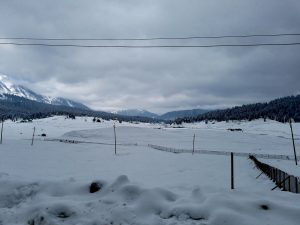
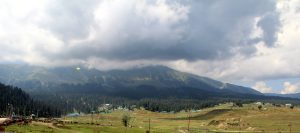

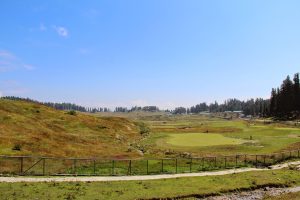
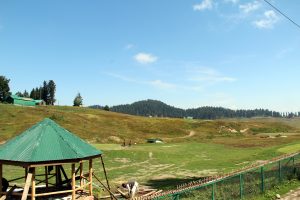
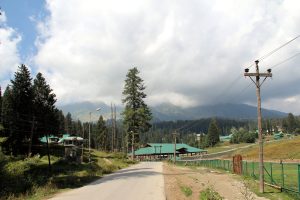
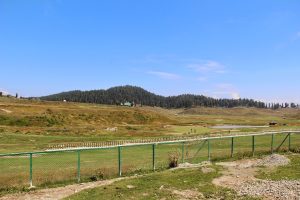
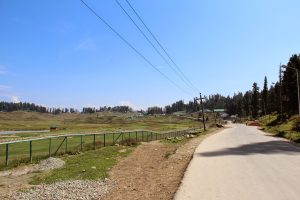
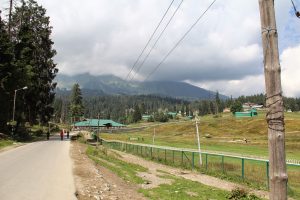
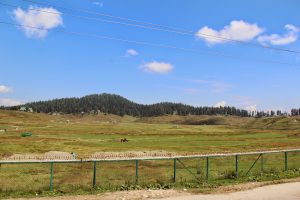

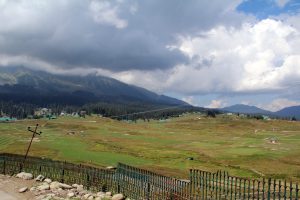
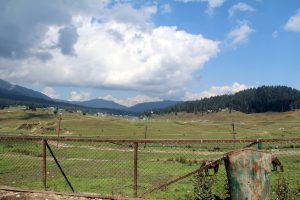
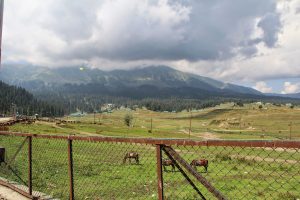
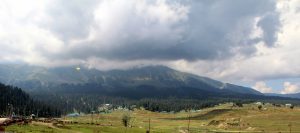
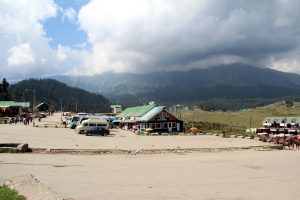
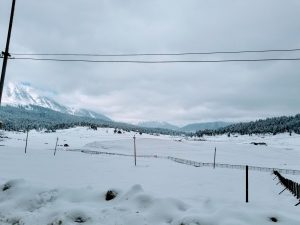
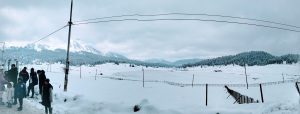
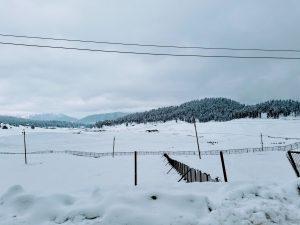
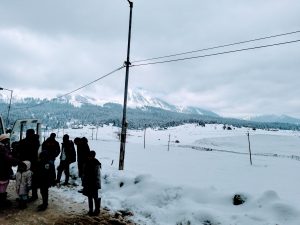
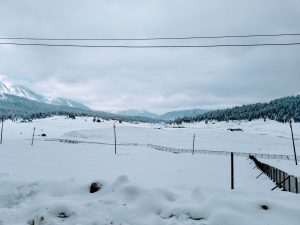
Siesta At Mansbal Lake
On a weekday, in the early afternoon, I reached Mansbal Lake. It is a small, pearl of a lake, placid, unpretentious. Its appearance and size makes you connect with it quickly. Unlike its famous sister, Dal Lake, Manasbal Lake is easier to understand and absorb. There were only a couple of dozen people in it during my visit. The mood was that of opulent tranquility, tender dreaminess.
Considered the deepest lake in Kashmir, at a maximum depth of 43 ft., it has engendered a myth that it is bottomless. A prodigious field of lotuses adorns it, which also makes it one of the largest sources of nadrus (lotus stalk), a popular item of Kashmiri cuisine. Then this is also among the top places to view aquatic birds. So many attributes for one splendid body of water.
After taking a wide and deep look at the lake and also taking all the photographs that I wanted to take, I decided to skip seeing the two important auxiliaries of the lake: a Mughal Garden, called Jarokha, built by Moghul queen Noor Jahan and the ruins of a 17th century fort called Darogabagh, also built by Moghuls, which used to serve as an inn for travelers journeying between Punjab and Srinagar.
Moved by the supine serenity of the place and privacy afforded by the virtual absence of people, I decided that I must take a nap under a tree, an image of bliss conjured up from my childhood.
I was very surprised by the choice of my activity, but I was being propelled by an inner force. I managed to land my aging frame on the ground, wrapped my camera round my right arm, and closed my eyes. I was amazed to see the Lady Sleep slowly curling her arms around me; I passed quickly thereafter. When I opened my eyes I saw that I had been in the other world for 45 minutes. Clearly Manasbal Lake inspired me to ignore everything: time of the day, public location, busy schedule, my past inability to sleep during daytime, and took me in her arms. That was incredible to me, as I am almost never able to sleep during daytime. I was quite elated by my performance because coming from a materialistic culture, in which people are always looking at their watches, to find enough inspiration and peace of mind to cut myself off from the world was no easy task.
I took a few more photographs and once again looked deep into the lake, to absorb its spirit and charisma. Slowly, but reluctantly, I walked toward my waiting taxi. On the way to Dal Gate we passed through many villages and hamlets, and the town of Ganderbal. People looked so much simpler and less stressed than their counterparts in the Western societies.
The siesta at Manasbal Lake started to sink in me, and I realized it was one of the defining moments of my trip to Kashmir, for it symbolized that I had arrived at a stage in my life, when I could distance myself from the material universe around me for some time.
Suffern, New York, Oct. 9, 2011 www.kaulscorner.com maharaj.kaul@yahoo.com
Fleeting Moments At Pahalgam
It was August 15, I was going to Pahalgam after 23 years. Besides the overriding urge to see a beloved place, I was also keen to see the changes in it, that time inexorably brings to almost everything.
Some very happy moments of my life have occurred in Pahalgam. Human happiness is a very complex thing: it can depend upon the circumstances of one’s social, economical, and physical lives; the point at which one is at in one’s self-discovery and one’s goals in life. Needless to say, being in Pahalgam itself must have been a very big catalyst in those moments.
My van passed Anantnag by the bypass road and almost everything about the road had changed: width, quality, traffic, and shops. The change was so sweeping that I even missed spotting my in-laws’ former house. Getting closer to Mattan, I was excited by the anticipation of it, but it never appeared, because we were on a new Mattan bypass road. On the way to Pahalgam we pass by many villages and hamlets. They seem so human and primitive that I felt that I should stop at each one of them, to walk through their lanes, do window-shopping, and perhaps talk with some people. The idea of their simplicity: lack of sophistication, guilelessness, and directness were very attractive human attributes for me, especially coming that I was from a highly materialistic, self-centered, and self-conscious culture. But I was unable to stop and indulge in my fancy due to the paucity of time.
For most of the trip, from just a few miles outside Srinagar to many miles before Pahalgam, there is a backdrop of the high mountains. This special drapery gave not only the particular road I was travelling on, but to the whole valley of Kashmir, a special aura. Just journeying anywhere within the valley is a special treat.
Getting close of the periphery of Pahalgam spurted my excitement high. Suddenly, a corner of the familiar ring of the mountains around Pahalgam appeared, followed gradually by the entire ring. Here I was again in Pahalgam! The incredibility of this fact kept me nagging for several minutes, till my subconscious finally admitted that I was in Pahalgam. We quickly passed through the downtown, a strip of contiguous shops, on an arched road. Within a few moments of passing through the bazaar I concluded that almost all of them had undergone changes, either they were rebuilt or were upgraded. Shop signs announcing Kashmiri shawls and handicrafts swarmed swiftly. Horses, highly emaciated, with or without riders on them, dotted the scene. That there were not a large number of tourists in Pahalgam was no surprise to me, as Amarnath Yatra had just ended, on Aug. 12. The lineup of the big three hotels: Hotel Pahalgam, Woodstock, Mountview, on the left side of the main street became visible. After the fleeting initial view of Pahalgam, I directed my mind to find out quickly where I was going to stay. From my homework about it in Srinagar I had concluded that besides the three hotels just mentioned, one could also stay in Grand Mumtaz. My taxi driver suggested considering staying in a hut too. We quickly went to see them and after looking up one of them I decided they were not good enough. After that we went to Mountview and I was shown an available room, which the hotel management said had the better view of Pahalgam compared to others. I liked it at once. Because of the view it commands, its location, and the quality of its rooms, Mountview is one of the better places to stay in Pahalgam.
Years back Mountview Hotel was called Wazir Hotel; then in 1987 its young manager suffered a heart attack, compelling him to sell it. But the name Wazir Hotel had already been changed to Mountview Hotel. In 1995 the hotel suffered a big fire, resulting in its rebuilding.
Immediately after checking in the hotel I went to view the central area of Pahalgam, which I call its “face.” I saw the gushing Liddar swarming over the continuous bed of rocks strewn over its path. It is an enchanting sight, one of the salient features of Pahalgam’s beauty. Lifting my eyes from the river I saw the magnificent presence of the ring of the mountains surrounding Liddar. In fact, Liddar without these mountains would not have amounted to much. I realized that Pahalgam, essentially, was still the same as it was 23 years ago, because the mountains and Liddar had not changed, which comprised its essence; rest of the elements were insignificant. The beauty of the mountains is greatly enhanced by the tapestry of the gracefully tall and slender pine trees.
Looking at the “face” of Pahalgam I felt that it was just an unsophisticated patch of land, bald at many places, with weeds growing at other places, just a few flower beds adorning it. What a waste of a great opportunity! Here was a place which could have been turned into a beautiful garden, having benches in it, sitting on which one could linger on the magnificent valley around. The state government, the custodian of the land, has not thought much about beautifying it. They have thought that keeping the land free of commercial and private buildings is the highest care they can bestow upon it. Their lack of imagination has been a great disservice to Pahalgam, the top attractor of visitors going to Kashmir. It could have called for proposals to landscape the area from internationally renowned park landscapers, and then the winning design could have been implemented locally. The state has followed such a route in the development of tunnels and a cable-car project. Exactly the same is the fate of the Gulmarg “face.”
I took a trip to Aru, a hamlet about 8 miles from Pahalgam. Throughout the journey the scene was so lonely that you felt nature whispering in your ears, “I am here.” Magnificent views of Liddar valley are present. I repeated taking a photograph of the site that I had taken 37 years ago, but the results showed that the earlier one was superior. Aru is a very low-key hamlet, which only swells to life during Amarnath Yatra. I could not but think of the life the local people, Gujars, lead. They are a nomadic people, who live in the mountains. It is quite apparent that they lead a very simple life, shorn of the fuss we city dwellers make. Above all, they lead a truer life. Living on bare essentials, in the intimate company of nature, they feel the pulse of life which many “civilized” people do not.
There are many new hotels in Pahalgam ; among them Grand Mumtaz is one of the better ones. A beautiful golf course has been constructed last year, which happens to be next to the hotel. The downtown has expanded at the town entrance area. Some roads have changed. Pahalgam is not a place for entertainment, that is, there are no bars, nightclubs, casinos, movie halls, etc. Because of the prohibition on serving alcohol, no hotel can serve it, and there are no shops selling it either. So, the drink lovers feels unfairly punished, but the smart ones among them bring their liquor with them. In my short experience in Pahalgam, I did not have much luck with the quality of food. Dinner at Woodstock was a disaster, experience at Mountview was just a little better. A Hotel Pahalgam restaurant (outside it) did not serve Kashmiri cuisine.
Pahalgam is a dreamy place, as is the characteristic of most of the Kashmir scenery. No wonder that has influenced Kashmiris to be dreamers. We can also say that Kashmiri scenery is meditative, but that has not helped Kashmiris to be so in the modern times, though in the ancient times they were steeped in it.
Memories of the past numerous trips to Pahalgam flashed in my mind. In 1959 I spent about six weeks here with my uncle, who was the chief physician of this place at that time. I was in a transition between my appearance in the intermediate college exams and their results. My parents and siblings were in Cairo, Egypt. Here was an interlude free of work, social responsibilities, and stress of any kind. It was as if I was travelling in a boat, on a calm river, surrounded by breathtaking scenery, journeying without a destination. My uncle and I were the only two occupants in his apartment for some time, which later changed with the arrival of his niece, with whom I got along very well. Day after day was an enchanting experience. I fell under the spell of a nurse working under my uncle. The sadness of her life penetrated me deeply and stayed with me for many years. Even more than the circumstances of her life, I was struck with the way she was facing them. She lived her life with a calm dignity and heroic acceptance of the tragedy. She had a poet’s appreciation of life. For years I wanted to meet her again but the practical difficulties hindered that.
I was also reminded of my trip here in 1974 when my parents and another uncle and aunt were with me. It was a splendid vacation for more than one reason: right time in life, right company, right mood. All the four have left the world. Each one of them was a special person. Only the memory of their personalities, conversations, time spent together, and good deeds remain.
Every day I went out for morning walks to Liddar bank, looking at the marvel of the total scene, feeling that man was not alone, he was in company of a lofty spirit.
On Aug. 17, two days after arriving in Pahalgam, I decided that I must move on to the next place in my ambitious trip to Kashmir. Much as it made me sad that I was walking away too soon from one of my most beloved places, but I had no choice.
The fleeting moments in Pahalgam had revived my old self, dreams, and love of life, even as they were accompanied with some of my old pains.
On leaving Pahalgam I felt pretty confident that I will be returning to it in not too distant future.
Suffern, New York, 10.6.11 www.kaulscorner.com maharaj.kaul@yahoo.com
The Trip To Touch The Hallowed Land
The visit to Srinagar, Kashmir in Nov. – Dec. 2002
I had been haunted and agonized by the idea that I had been unable to go back to my birthplace Kashmir for fourteen years. Darkly hallowing this idea was the anguish I felt over the death of some sixty thousand people and the driving out of the whole community of Kashmiri Pandits, the original settlers of the land, by a degraded and a dishonorable war, which has conflagrated the place for the last fourteen years and is ongoing, perpetrating the fraud of seeking to give Kashmir’s Muslim inhabitants their supposedly long sought after freedom.
I made an attempt to visit Kashmir during my 2000 trip to India but was rebuffed by my flimsy planning, reinforced by half-willed ambition.
In 2002 I made good of my earlier failure, which besides other things meant riding rough-shod over well-meant advice and conventional wisdom of my relatives and friends to avoid this dangerous area . A plan to visit Srinagar, Kashmir was made and it was executed, enabling me to fulfill the long cherished longing of touching the hallowed land of my ancestors , my birthplace, and the site of my early adulthood, which now lay crassly defiled and its people deeply wounded.
The flight from Jammu to Srinagar, though of only twenty-five minutes duration, was choked with unshakable trepidation, stressed with over-controlled excitement, and buffeted with the slow release of cloaked longing. The sight of the Pir Panjal range of mountains was the sounding of the bugle of welcome to the Valley. Within minutes after the welcome call was the sight of the Valley itself – veiled with the thin veneer of clouds with enigmatic movement. The first look of the Valley at this point from the vantage perspective of the ten-thousand feet elevation is that of a semi-real place –magnificently contoured by mountains, the valley below diffused though panoramic. The sun was shining lavishly on this day in November.
The passage through Srinagar airport security was rather too smooth, considering the danger afloat in the place. My host and I recognized each other with electric intuition, though having never met before, and we began the drive to Amira Kadal, Residency Road, Bund areas, the grand piece of the mosaic of the city of Srinagar. There was a new road coming out of the airport. Looking at a distance one noticed new construction, something which warmed my feelings in that that in spite of the life crushing upheaval of the last decade and a half the emotion to live in the inhabitants of this place persisted strongly. Getting closer to the city the presence of military posts and their frequency was one certain sign of something having gone terribly wrong with this place. The traffic in the heart of the city was heavy, again giving the impression that life was going on, in spite of the horrific situation surrounding it. The Lal Chowk, the center-square of the city, seemed to be a washed out picture of its previous glory. Beyond it, toward Partap Park, the scene seemed even feebler. The Bund, the riverside boulevard, the heaven of the evening walkers, was completely deserted, its legendary shops, I am sure, were almost completely empty. Even accounting for the winter low turnout of people, the sight seemed mournful, more perhaps because of its contrast with its past grandeur.
Traveling through the core downtown areas, some of which I was seeing for the first time, I got the chance, which I greatly wanted, to have a glimpse of the surviving real people of Kashmir. In the dilapidated structures, often bereft of light and air, almost always without the modern amenities of life, live human beings who have taken the heaviest brunt of the brutality of the last decade and a half. These are the people who by now have forgotten which side of the war they are with. Some seventy-five years ago, a great son of theirs, Sheikh Mohammad Abdullah, fought for their freedom from their historical backwardness. In 1947 they were ushered in a new age of democracy, both political and economic. In the subsequent four decades they were transformed from landless tillers to landed gentry, from the lowest rungs of the social ladder to the top echelons of wealth and political power. But yet they were thrown into another fight for their freedom in late 80’s, this time for a state based on their religion. But this fight proved to be very difficult, pulling immense sacrifices from them, and its conclusion is very much under a cloud as to whether they have any chance of winning anything of what they wanted.
The famous Kashmiri stylized walk, a picture of body coordination and intense self-consciousness, was still alive. People looked terribly preoccupied and yet seemed to walk with a purpose. They seemed not to socialize while walking. Behind their apparent calmness and focus they seemed to cloak something. What is on their minds, one wondered. Shops filled with packaged goods looked awaiting customers. Cars and micro-buses running with heavy punctuation of screeching horns and brakes, just always managing to miss pedestrians. A bizarre traffic scene, perhaps without a duplicate in the world outside India.
Frozen in time, the Srinagar downtown is a vibrant organism, where political and social emotions run deep and strong and primeval personality reigns. People are intensely involved with themselves and do not pay much attention to the other parts of the world. Their stubborn loyalty to their traditions, ideas, and emotions can not be bought off. The buck seems to stop here. Their stoic acceptance of their sufferings engendered by the political war in the area is sustained in good measure by their belief in the rightness of their political positions. The mixture of pride and stubbornness, non-conformism and fatalism, forms the essence of Kashmiri personality, which unfortunately has come to become an immense barrier in the resolution of the ongoing civil war.
River Jhelum is the centerpiece of the city of Srinagar, intertwined with the daily lives and the culture of its people. It is not sinewy like Seine in Paris or wide like Hudson in New York, but is physically more intimate with the surrounding habitation than them, like a street running through the town. During winter its water level falls significantly, exposing the unsightly shores. Three new bridges over the river have been added: Biscoe Bridge (south of the demolished Fateh Kadal), New Habba Kadal (south of the old but still used Hubba Kadal ), and New Zero Bridge (north of the still used old Zero Bridge). I was told that the statue of Tyndale Biscoe which was erected on the west end of the bridge named after him was demolished by the local people, presumably on the ground that he as a foreigner was unacceptable to the sensibilities of Islam and their culture. Biscoe was a shaft of light in the Kashmir of early last century with his creative ideas on education and the school he left has continued to remain a gleaming institution of character building and learning. The topic of the bridges reminds me of another noble soul, Bad Shah, for whom Bad Shah Bridge is named. His official name was Zain-ul-Abidin, who ruled Kashmir from 1420 to 1470. His treatment of Hindus and tolerance of Hinduism was such that his reign is considered a high-point in the Hindu-Muslim relationship since the advent of Islam in Kashmir in 1339.
Driving down the Srinagar downtown sights of the burnt Hindu houses are frequent. It is amazing to see the precision with which the fires have been extinguished just at the boundaries of the targeted houses, leaving the adjacent houses intact. Most of the burnt houses have not fully burnt, leaving the wooden structural members and the masonry at precarious positions, posing safety risks. Either Government has thought the posed danger to be insignificant or has not thought at all. The thought comes of what were the Muslim onlookers doing when the militant targeted houses were burning. The inhabitants of the adjacent or adjoining Muslim houses must have been tearing with fear of their houses catching the fire. But most likely the fire starting people must have taken care of the situation and assured the Muslim neighbors that their houses will remain safe. Also, frequently visible were the shuttered up Hindu shops which, most of them, I was told, had been by now sold to Muslims. What do Muslims feel and think when they see amidst them the burnt houses and the shuttered down shops?
There are much lesser number of people walking on the streets than before. This can be explained as an enormous number people have died, almost the entire Kashmiri Pandit community has emigrated out, and a lot of Muslim young people have also emigrated out of Kashmir, many of them going to the Middle East. The downtown looks like a semi-deserted town, with little excitement and cheer; everything seems gray, solitary, and feeble. Where is the hustle and bustle of Habba Kadal, the tension on the streets, the excitement of the school children, the energetic solicitation of the shopkeepers, the aggressive haggling of the shoppers? The acute shortage of electric power resulting in its daily rationing does not help the stained ambiance of the place. The semi-lifelessness of Srinagar and environs, and we can venture to stretch this condition to the entire Valley, is emblematic of the decade and a half long barbaric activities in the area. The Kashmir Valley is a humanized prison-camp.
I ventured into the old Fateh Kadal area to see my ancestral home at Malik Yar. This place is now close to the new Biscoe Bridge, which replaced Fateh Kadal. Kauls had lived at Malik Yar for generations in a compound comprising several houses, which in its heyday may have amounted up to nine families. Now there was no one of them living here, though most of the buildings appeared to be on the ground. (In fact a new building had arisen on a compound, which was used as a playground by the children). A black patina had grown over some of the buildings, an effect accumulated by time. The complex seemed to echo loneliness and abandonment, neglect and unhappy times for the people living in it. I introduced myself to some young women who careened out of the windows to sight the stranger standing in their compound and photographing the structures. They appeared to be defensive in their being the new occupants of the buildings, which were once owned by my families, saying that they had moved from the immediate neighborhood. Some of the neighbors, whom I had known since the early adulthood, came out of their windows inquiring about the welfare of my other family members and inviting me to tea, a customary gesture of welcome and friendship in Kashmir and many other parts of India. I was amazed to see how even the long stretches of silence among neighbors had not dulled their ardors of friendship. Some human relationships can defy the dilution and disintegration engendered by the unwearied assault of time. Scenes of my childhood flashed in a stream of consciousness mode through me: playing, going to school, fear of elders, excitement on festivals and weddings, growing awareness of mystery of life and efforts to keep it cloaked from others, lest I be taken as a lunatic (a fear which has not completely left me even now). I tore myself from the physical backdrop of my early life as prolonging the stay, I thought, might cause a stir in the neighborhood leading to some problems with the militants. As I left I thought someday I needed to return here in greater inner tranquility to contemplate my early life and the growth of my consciousness.
From the old Fateh Kadal area I moved to Karan Nagar, not a downtown area, and also not an old area, inhabited mostly by middle and some upper class people, mostly Hindus. It appeared to be mostly intact, viewed from its central boulevard. Furthermore, new shops have erupted in its northern section. Here I looked for my uncle’s home, where I had spent a lot of time. It had become my home too as my father moved from country to country as a professional diplomat. The house was sold by my uncle in 1999. The new owner owned it for a short time only, demolishing it to construct a diagnostic center, which is a much bigger structure than the former building. Ironically, my uncle had named the house “Smiriti,” a Hindi word meaning remembrance. All that was left now was the remembrance of the “remembrance.” So much of human life is lived in the structure of mind, a situation commonly unappreciated by people.
While Srinagar, even in its heydays, was at best a medieval city, now it has taken the looks of an ancient city. The Dal Lake and the high mountains around it have given it a splendid backdrop for thousands of years. The city is like a poor, common looking woman, who has been dressed in a magnificent gown and a resplendent and a noble headgear, lifting her to a level of superb majesty and mesmerizing beauty. Dal Lake is serene, modest, and mystic. The mountains around it stand in a stance of frozen eternity, sentinel to the lake, their light brown luster radiating warmth and glory, standing in an obeisance to Gods. Without a visit to the lake and the several gardens fringing it the visit to the city is incomplete. It is in this spirit that I visited these places, even as I was absorbed in the tragic experience of Kashmiris in the last fourteen years.
Driving down the Boulevard toward the Moghul Gardens nothing much seemed to have changed except that more hotels and Kashmiri crafts showrooms had emerged across the road from Dal Lake. The unpaved footpath along the Boulevard remained unpaved. The lake looked forlorn. I was too focused on the general appearance of things that I paid no attention to its state of cleanliness. Even though it was sunny a thin veneer of fog covered the lake as if to defend its privacy in these flagrant times. Not many people were either on the lake or on the Boulevered. I entered Nishat Garden after twenty-six years. I found its fame of a transcendent work of art highly exaggerated. Though it is beautiful but its beauty is more due to its setting in its surroundings than due to its intrinsic merit as a garden. Its much ballyhooed terraced layout is no wonder. The garden may have looked fabulous in Moghul era and a few hundred years after that but it has not been upgraded to the present standards of gardens and that too of famous gardens. The stonework, fountains, pathways, turf, shrubs, and flowers are crying for upgrades. Without the mystic tranquility of the lake in front of them and the grand dignity of the mountains around them, Nishat and other Mughal gardens would have been very commonplace gardens.
The gardens were deserted as expected at this time of the year. The turf had turned light brown and there were no flowers left except of one variety. In their bareness the gardens revealed the structural deficiencies they have been carrying on for a long time. I could only remember the magic they cast on me and others decades ago, when the times in Kashmir were more human and I had not been exposed to some of the other gardens in the world. A garden is an expression of human heart but woven in the strands of human mind.
I visited Palace Hotel, now bought by someone from its previous owner, Oberoi. It seemed no one was staying there at the time. What made me go there was the experience of the beautiful sight of Dal Lake, Hari Parbat, and the high mountains beyond that I had in 1988. But I found some of the trees dotting the hotel property had been allowed to grow so tall as to block some of the grand view. Furthermore, the fog on the lake and clouds in the distance had changed the scene dramatically. Same could be said about the view from Shankaracharya, the place where I went next.
As the hour of my departure from the Valley drew nearer I could not help thinking of the mood of the place. It looked as if a public mourning was going on that was hiding some loss greater than what it indicated, in public’s hearts and minds. Behind a facade of life-as-usual look people were unconsciously harboring a deep hurt, a deep loss, a break from an anchor. A state seemed to have evolved in their minds when there was no need to express their anguish, no desire to find out the agents which extinguished the flames in their lives. The people seemed to have crossed into a terrain where there was no hope at the moment and no need of regaining it. They were beyond Hamletian “to be or not to be” question and into acceptance of their existence as it was.
For my hosts my visit was a dramatic homecoming, coming as it was after a decade and a half, for which I was taking a security risk. They worked very hard to make it comfortable and secure and they were concerned every second that I enjoy it. Little could I tell them that I had not come to Kashmir to enjoy it – I could not do that even if I wanted to do it. The purpose of my visit to Kashmir was to feel the pain of the people living there who had gone through heart and home wrenching experiences in the last decade and a half, to see the destruction of the place I was born in, to rekindle the earliest memories of my life, to touch the hallowed land of my ancestors. I put in the hardest efforts I could command to cover my pain, to hide my sleepless nights. But in the end I realized that it was futile as my hosts understood what I was going through, through the invisible lens of the human heart, through the penetrating field of the human mind. When I said goodbye to them I felt as if I had known them since the first crack of my consciousness, as long back I had known the mountains surrounding Srinagar.
This journey to the ancient sources of my consciousness was surrealistic and sensitizing, opening ancient wounds and blurring new dreams, baring the fragility and the absurdity of human life, and bringing to focus once again in my long quest of the understanding of human life the power and drama of human condition.
As I sat in the plane ready to leave Kashmir I looked through the window at the brownish mountains afar. I was transported to the most ancient times of my life. Like an umbilical cord connected to a human baby at birth, Kashmir had breathed and sustained life in me not only at my birth, but directly and indirectly, throughout my life. Beyond my own life, small and insignificant that it is, were the lives of several millions of people dependent on it both physically and mentally. I could not help feeling sorry how Gods had given this near perfect land to Kashmiris and what they did to it. A beautiful valley was turned into a torrent of blood, a benign brotherhood between Hindu and Muslim communities was transformed into a relationship of hatred and vengeance, and a tranquility in the hearts and minds of the people was replaced with perturbation of anguish and disillusionment. I was reminded of a stanza of my poem Roots:
We do not know where to begin anew –
Even, if we should begin at all,
To resume God’s work,
To revive the spontaneous sparkling smiles
On the faces of a thousand gloomy children,
To let the lotuses grow unperturbed.
When the plane took off the ground I felt sorrowfully that most likely I will be unable to return to Kashmir, given the ruination Kashmir was continuing to go through, given the irreversible erosion of my own life.
